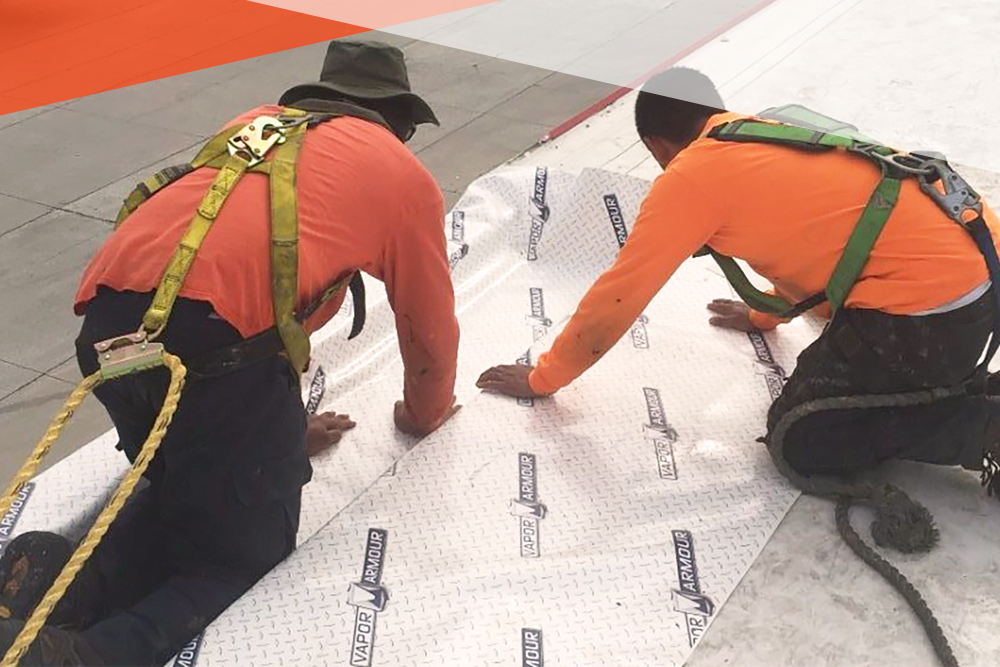BY RANDY BOGRAND, COO
We’ve all been there. A member of your crew comes with news of a slight problem. They’ve spotted condensation, and before long you have frost, and then icing. You may know the problem is a breach in your outer Vapor Barrier protection, but if you’ve been here before, you also know the traditional solutions are costly, time consuming, interruptive, messy, and temporary.
We’d like to share a solution that can permanently fix your Vapor Drive problems, pay for itself in an average of three years, and help your company’s bottom line by adding more than a decade of extended energy savings, past the point you receive your ROI, all under warranty.
To explain how this is possible, we’ve put together a deep dive into our process that shows you the steps we take to mitigate and remediate Vapor Drive problems for our clients. But the real credit for the success of our patented process is two materials that provide the insulating power, and the compression sealing ability of the Vapor Armour system.
Insulating Power
First, we’d like to introduce Dupont™ Grey Board insulation panels. If you’ve been around the industry long, you may think you’ve seen this before, and you’re close. But what most cold storage warehouses have been roofed and insulated with in the past, was Poly Iso, poly styrene insulation. While the chemical makeup is similar the main difference lies in the cell structure of the panel itself.
With the most common type of foam panel insulation, known as EPS, or Expanded PolyStyrene, tiny beads of foam are compacted together, then heated, until they fuse with one another, creating the effect of a solid sheet. In reality, this sheet is more like Swiss cheese, then say a solid sheet of plywood. These foams are formed from PolyIso (Polyisocyanurate), an open cell foam which can be formulated from a variety of organic and inorganic substances.
The structure of the panel is known as “open cell” because the gaps between the beads, though fused solidly together, can hold air pockets, or even condensation. In cases where Vapor Drive is present with EPS roofing, condensation cannot only enter the insulation, but penetrate and permeate it, until it becomes essentially either a solid block of ice or a wet sponge – with a no R value. In addition, the presence of sustained moist conditions virtually assures the growth of mildew and mold, both considered actionable contaminants under the FSMA which can shut your facility down for remediation, or even permanently if not abated.
Grey Board is different in two ways, first, Dupont first formulated this structure in a product called Blue Board, which is a familiar foam panel insulation. Blue Board, instead of being heated and fused, is actually “extruded,” think of the Play Doh™ machines we used as kids. The molten foam is squeezed into a form, then pressed and cut into sheets, creating a more solid, “closed form” structure that resists moisture penetration. The material itself is “hydrophobic” meaning it repels water, and since there are no gaps, it repels permanently, even if set in standing water.
In addition, new regulations around a factor termed Global Warming Potential, or GWP are coming online in the manufacture of building materials, to curb the greenhouse gas emissions from manufacture. Grey Board should rightly be called “green board” for its environmentally friendly manufacturing process. Meaning, it is built to exceed the GWP standards currently in place across Canada and much of the United States.
This Grey Board has the same architectural and engineering properties of the Blue Board that preceded it. It has the improved R value and durability of the improved Blue Board, plus, it is environmentally sound and sustainable. Which, for us, makes it a triple threat, and the natural choice for installation in all Vapor Armour compression seal installations.
Vapor Armour™ Membrane
Since we wanted to give the best possible warranty, we needed a material that would serve to stop air from entering our client’s facilities in a permanent fashion. Enter Vapor Armour ™ membrane.
First, let’s look at the problem. The potential for Vapor Drive, warm air, entering a colder, controlled environment, which leads to condensation, frost, and icing, mainly exists at the junction between roof and wall systems. In cold storage construction, we don’t argue that the roof, nor wall systems are deficient (although some could be installed in a manner that makes them more efficient), they serve their purpose at stopping the elements.
The problem lies in the gap. Isn’t that always the way? It’s the space between your expectations (my building should maintain a constant temperature and fight condensation and icing) and the reality (it’s been a year since we built, and we see ice already). That’s where your disappointment lies, much like the Vapor Drive issues primarily occurs at the gap between roof and wall systems.
Enter the main industry solution, spray foam. We’ve got a lot to say about spray foam in another of our blog posts so let’s not get into that here, suffice to say, it’s inefficient and a short-term fix at best. The problem does not lie in the spray’s ability to insulate, which is great. We also don’t see spray foam absorbing water, like EPS insulation can. The main problem is also one of its greatest strengths as a building material: It is INflexible.
Unfortunately, your facility flexes.
In fact, the walls of your building may be moving due to expansion and contraction throughout the day as temperatures change at the rate of more than one inch every forty feet of wall. Spray foam simply cannot, and will not flex that far, without breaking its seal, and the seal, as the entire industry acknowledges, must remain constant to block air.
In order to mitigate this problem, a system of multiple parts is required, and the roofing industry gets part of this correct – when they use a flexible, monolithic membrane as the top layer of the roofing system. But they stop short.
While there is much to be said about the superiority of the proprietary PVC membrane we use in Vapor Armour compression seal and roof installations, that can be said another time. The real secret is what happens with the “gap” from where the roofing leaves off and the top of the wall. This is the area most builders simply fill with spray foam and affix the roof over the edge.
Vapor Armour considered the needs of the structure.
- It needs to maintain a constant inside temperature to ensure food safety.
- AIR needs to be sealed-out from entering, which blocks warmer, penetrating air, or “Vapor Drive”
- The vapor barrier needs to “move” with the facility (expand and contract) with changes in temperature.
While the first is being addressed, the second and third most crucial factors are entirely overlooked.
Enter Vapor Armour™. This proprietary flexible membrane is integrated into the roof, buried beneath the roofing membrane, where it is permanently attached to the roof deck. It then extends up, (and over any parapet wall) and over the edge gap and down the wall – where it is then secured permanently to the wall.
This membrane is impermeable to both air and water, and flexible enough to meet the demands of expanding and contracting structures. It effectively ends Vapor Drive and can be installed around any penetrations in the building envelope, such as utility lines or vent pipes.
Between the superior value of XPS insulation, and the correct installation of a Vapor Barrier to cover the wall/roof junction, the Vapor Armour system can produce staggering results. Not only are our installations better able to maintain constant temperature, but they do so using less energy, between 17 and 35% less energy!
We’d like you to take the Vapor Armour challenge. Call us today and have our team out to do a free invasive forensic assessment of your cold storage facility. We will listen to your team, follow their lead on where most of the problem lies, and investigate the remainder of the structure to see how far the problem has spread and propose a permanent solution.


